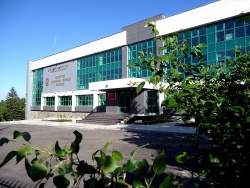Institute of Solar-Terrestrial Physics of Siberian Branch of Russian Academy of Sciences (ISTP SB RAS)
About Us
From ISTP SB RAS
| Revision as of 00:41, 23 March 2017 (edit) Admin (Talk | contribs) (→Short information) ← Previous diff |
Revision as of 02:30, 24 March 2017 (edit) (undo) Admin (Talk | contribs) Next diff → |
||
| Line 1: | Line 1: | ||
| - | {| | + | {|width=50% style="margin: auto; text-align:justify;" |
| | | | | ||
| - | [[Image:ISTP newFoto.JPG| | + | |
| - | + | [[Image:ISTP newFoto.JPG|thumb|250px]] | |
| ===Short information=== | ===Short information=== | ||
| + | |||
| Founded in 1960 on the basis of the Siberia's oldest geomagnetic observatory formed in 1886. | Founded in 1960 on the basis of the Siberia's oldest geomagnetic observatory formed in 1886. | ||
| Director - D.Sc. (Phys.&Math.) A.V. Medvedev. | Director - D.Sc. (Phys.&Math.) A.V. Medvedev. | ||
| Line 9: | Line 10: | ||
| ===Major research areas=== | ===Major research areas=== | ||
| - | According to the | + | According to the Charter of the Institute, the main fields of research are as given below: |
| - | The | + | |
| + | :Fundamental, exploratory and applied research studies in the following main research areas: | ||
| + | |||
| + | ::*solar physics: study of structure and activity of the Sun and sunlike stars; physics of solar flares and coronal mass ejections; study of the Sun evolution, structure of solar magnetic fields and coronal plasma; helioseismology; radio emission mechanisms and methods of coronal plasma diagnostics; monitoring of active solar processes as the sources of disturbances in the heliosphere, magnetosphere, ionosphere and the Earth atmosphere; elaboration of new methods and equipment for astrophysics and solar physics research; | ||
| + | |||
| + | ::*near-Earth space physics: physics of the magnetosphere, ionosphere and upper atmosphere; study of the magnetosphere–ionosphere–atmosphere–lithosphere relationships; detecting mechanisms of the heliospheric factors influence on near-Earth space and the Earth's atmosphere, study of space weather effects; ionospheric radio wave propagation and radiophysical remote sensing methods; elaboration of new methods and equipment for diagnostics and monitoring of the environment (magnetosphere, ionosphere, atmosphere, lithosphere) and active impact on it; | ||
| + | |||
| + | ::*problems of asteroid and comet impact hazards and space ecology: development of optical and radio-physical methods in the fields of asteroid and comet impact hazards, space anthropogenic pollution and ecology; monitoring of space debris and condition of spacecrafts and stations; | ||
| + | analysis and forecast of state of the Earth's climate system: elaboration and enhancement of models of climate change physical mechanisms, solar activity taken into account; factors forming weather and climate; influence of heliosphere and geosphere factors on atmosphere and stratosphere-troposphere exchange. | ||
| + | |||
| + | |||
| + | The main directions of research comply with the Program of fundamental research for State academies of sciences for 2013-2020 (approved by the Russian Federation Government (resolution of December, 03, 2012, No.2237-р). | ||
| + | |||
| [[The Russian-Chinese Joint Research Center on Space Weather|Space weather monitoring and forecast in an effort to solve a number of applied problems;]] | [[The Russian-Chinese Joint Research Center on Space Weather|Space weather monitoring and forecast in an effort to solve a number of applied problems;]] | ||
| - | + | ||
| ==International collaboration== | ==International collaboration== | ||
| Line 28: | Line 41: | ||
| + | The main directions of research comply with the Program of fundamental research for State academies of sciences for 2013-2020 (approved by the Russian Federation Government (resolution of December, 03, 2012, No.2237-р). | ||
| The Institute holds annual [[BAYSIS 2007|Baikal Young Scientific International School]]. | The Institute holds annual [[BAYSIS 2007|Baikal Young Scientific International School]]. | ||
| The institute research assistants actively cooperate with research teams from Finland, Sweden, Belgium, Germany, the U.S.A., the Netherlands, the Czech Republic, Bulgaria and others. | The institute research assistants actively cooperate with research teams from Finland, Sweden, Belgium, Germany, the U.S.A., the Netherlands, the Czech Republic, Bulgaria and others. | ||
| + | |} | ||
| [[Category:The Institute]] | [[Category:The Institute]] | ||
| [[ru:Об институте]] | [[ru:Об институте]] | ||
Revision as of 02:30, 24 March 2017
Short informationFounded in 1960 on the basis of the Siberia's oldest geomagnetic observatory formed in 1886. Director - D.Sc. (Phys.&Math.) A.V. Medvedev. Total staff: 506, including 143 researchers, 36 Doctors of Science, 78 Candidates of Science, and 125 engineers, 124 - staff of observatories. Major research areasAccording to the Charter of the Institute, the main fields of research are as given below:
analysis and forecast of state of the Earth's climate system: elaboration and enhancement of models of climate change physical mechanisms, solar activity taken into account; factors forming weather and climate; influence of heliosphere and geosphere factors on atmosphere and stratosphere-troposphere exchange.
International collaborationThe Institute is participating in many international research programs and projects in the field of solar-terrestrial physics, realized mainly in the frame of bilateral agreements and treaties on scientific collaboration. The ISTP SB RAS has agreements with the following foreign scientific organizations:
|
